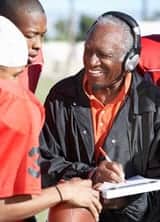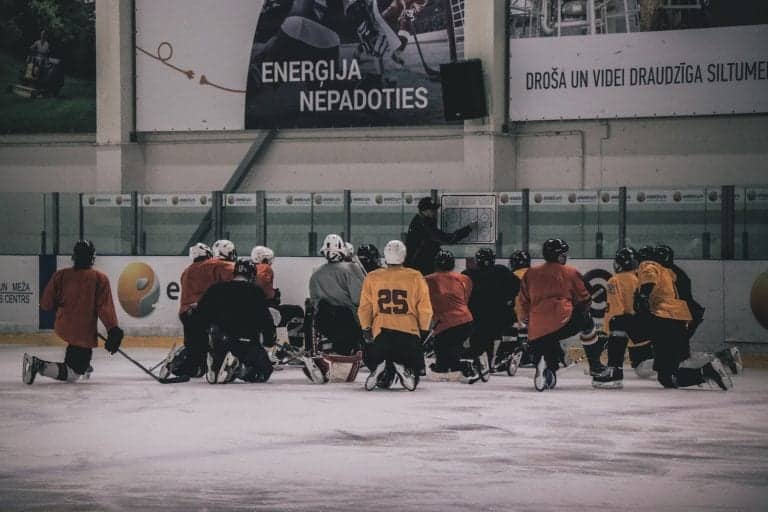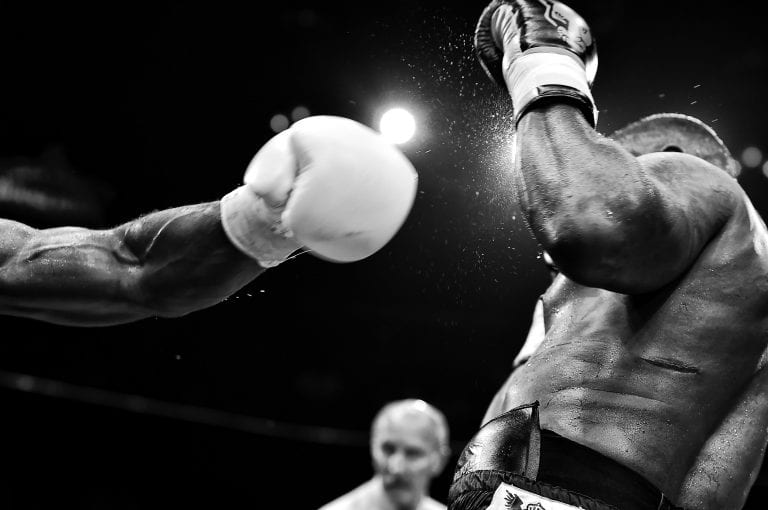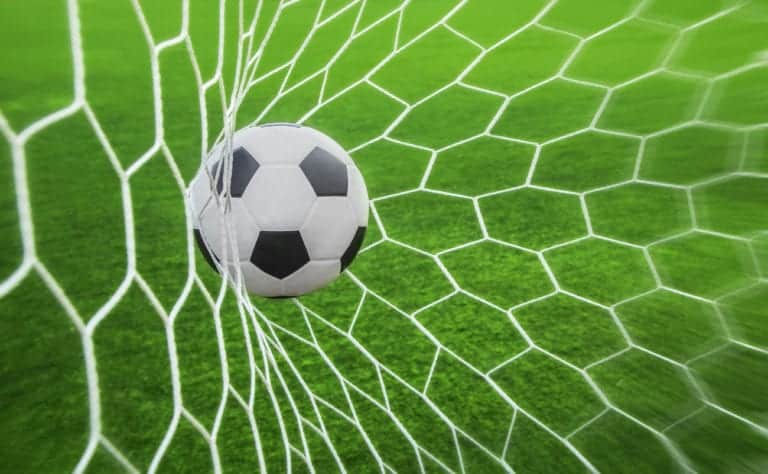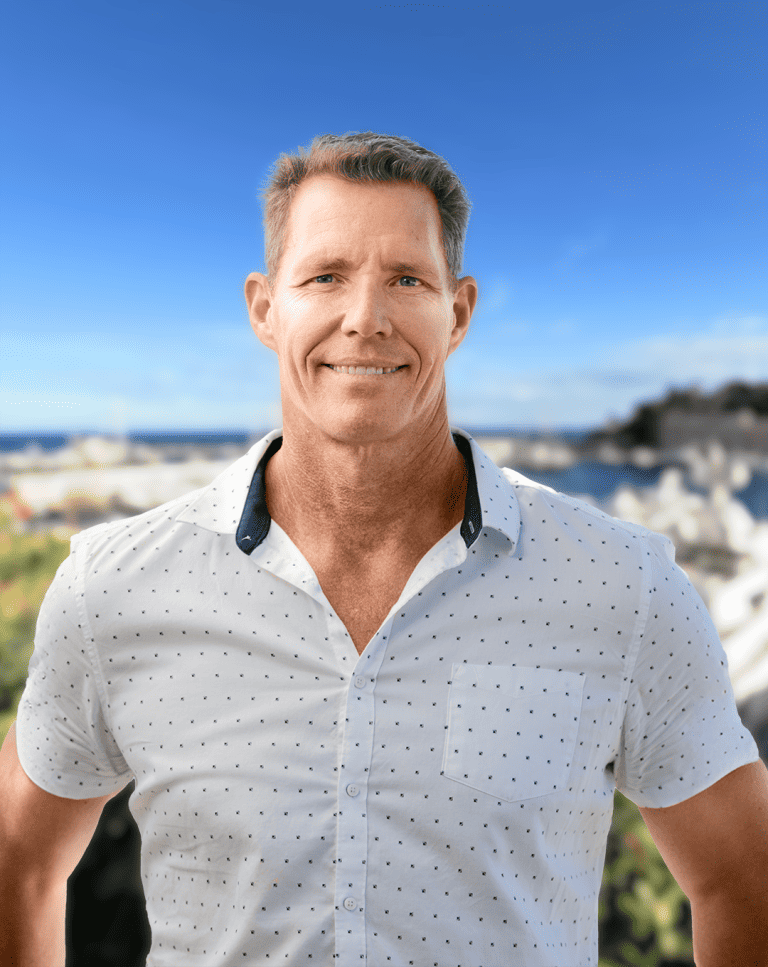As athletes we all start at the very beginning and over time, develop the skills and techniques needed to be successful in our chosen sport. This process can be defined by the Conscious Competence Learning Matrix, or a 4 stage model outlining the various stages of learning an athlete goes through in order to acquire new skills.
Coaches can utilize this method when teaching their athletes new skills, plays, systems and guiding them through a learning process. The Conscious Competence Learning Matrix is particularly useful in addressing training obstacles because coaches can ask themselves: “What stage is the athlete at and what is preventing the learning from progressing?” In this way the conscious competence theory helps coaches to understand far better why an obstacle exists, and how best to deal with the challenge.
And since the conscious competence theory forces analysis at an individual level, the model also encourages the athlete to assess their own individual development.
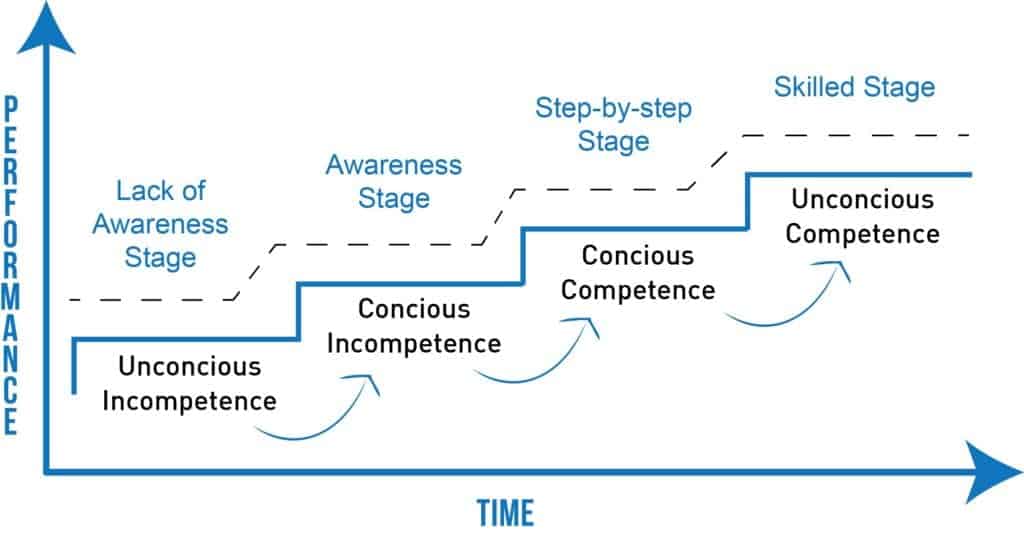
Stage 1: Unconscious Incompetence
Before we begin to learn a new skill, we may have a complete lack of knowledge of the need, use and even existence of the skill. I know it may be hard to believe, but no one knows everything about everything. For example, there are aspects of quantum physics that we as coaches are completely unaware of, and we are also completely unable to explain what we obviously don’t know to anyone else. At this stage of the Conscious Competence Learning Matrix, we are defined as being ‘Unconsciously Incompetent’.
Young athletes I coach in rowing have no idea of what a ‘force curve’ is, or what it is used for, or how to explain it to anyone or even vary their own ‘force curve’ when rowing in the boat. These young rowers are Unconsciously Incompetent. For me, having rowed at four Olympics in multiple boat classes, I was fortunate enough to study biomechanics through my coach, analyze the rowing stroke in great detail to the point where I not only know about force curves but can modify my force curve to suit the type of boat and position I row in the boat.
This stage of learning suggests I am Consciously Competent in my knowledge and ability to execute this rowing technique. My skills and understanding is greater than the young rowers I coach. My job then becomes educating them, and for me to do this, I cannot start coaching them at the level I need to be coached. I need to recall what it is like for them and then build the concept over time and help them to learn it.
In summary, this stage is where we don’t know that we don’t have this skill yet, or that we even need to learn it.
In other words, the young rowers completely lack awareness of the skill and need to learn it, so our job as coach, is to create awareness. To do this, I use a rowing machine (ergometer) and turn the digital screen to the ‘force profile’ setting to let them see the curve they create when they row. Now they are aware but still incompetent of being able to vary their curve.
Stage 2: Conscious Incompetence
To progress through to the next stage of the Conscious Competence Learning Matrix, stage 2 or ‘Conscious Incompetence’, the athlete must first become aware of their inability to perform the new skill so learning can begin. Then through practice, they begin to experiment, receive feedback, experiment some more and again through feedback begin to develop some level of competence. How long this takes is a function of many factors, such as desire, quality of feedback from the Coach, depth of athlete concentration, supportive environment and on it goes.
Stage 2 can be tough for an athlete and their coach because the athlete is now aware of the skill and the fact they need to learn it but still aren’t competent with it, yet they desperately want to be. At this point the athlete begins to realize how untrained they are at this new skill and many will realize how much they do not know and also, how much effort it is going to take to get to an elite level of performance. This is where some may give up and so as a coach, we have to be really supportive and encouraging or in DISC terms, we need to be the I and S style of coach. With our best coaching, the athlete will then ideally make a commitment to learn and practice the new skill. This sees them move on to ‘Conscious Competence’ stage 3.
Stage 3: Conscious Competence
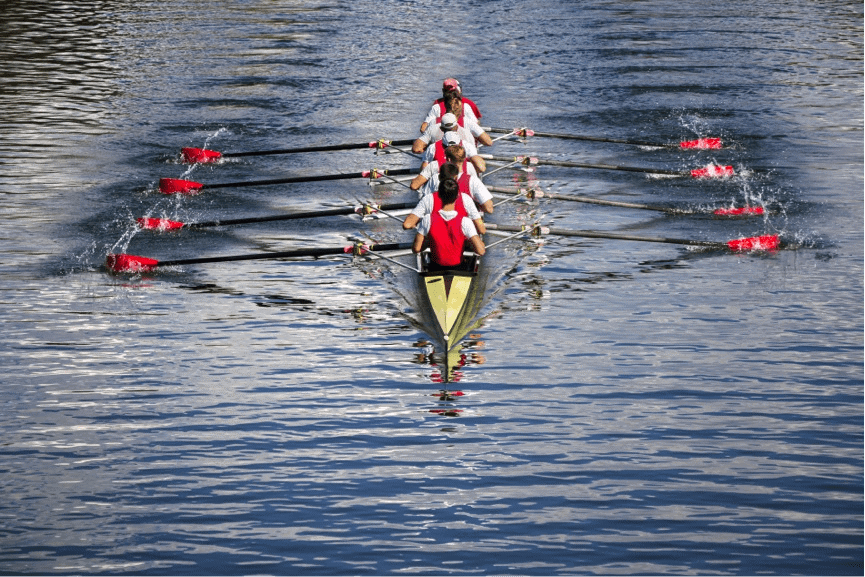 Stage 3 of the Conscious Competence Learning Matrix is where the athlete has acquired a new skill and they are now aware of this. They then put this knowledge into practice on a regular basis and gain more confidence in performing this newly learned skill. At the ‘Conscious Competence’ stage the athlete still needs to concentrate deeply when they perform these tasks and cannot do ‘two things at once’ so to speak. As they get more practice and experience, these activities become increasingly automatic.
Stage 3 of the Conscious Competence Learning Matrix is where the athlete has acquired a new skill and they are now aware of this. They then put this knowledge into practice on a regular basis and gain more confidence in performing this newly learned skill. At the ‘Conscious Competence’ stage the athlete still needs to concentrate deeply when they perform these tasks and cannot do ‘two things at once’ so to speak. As they get more practice and experience, these activities become increasingly automatic.
Using my rowing example, through practice, my young rower now understands what the force curve is, what their curve looks like and through experimenting themselves with my feedback, they have learned how to make their curve change shape through changing how to apply their legs and arms at differing intensities. At this stage of their learning, Conscious Competence means the young rowers can think about what they need to do and do it in a very structured and methodical way.
Coaches need to understand that practice is the single most effective way to move an athlete from stage 3 to 4 and we need to encourage continued learning and training at this point.
Stage 4: Unconscious Competence
Stage 4, the final stage of the Conscious Competence Learning Matrix is when the athlete has become ‘Unconsciously Competent’. This means a high skill level has been achieved and they can perform the task without conscious effort, this means they can do what is required in a type of automated way. The skill now seems easy and has become second nature.
Going back to my rowing example, a rower who is at stage 4 is able to row in any boat, any seat, at any time and perform at their best. They are able to adapt their stroke to suit who they row with and the speed of the boat they are in, and most critically, they can do this under Olympic Final pressure. Interestingly, what also happens at this stage, is the ability to almost multi task. What this means is the rower can call a race plan, make technical suggestions to crew members and be aware of opposition boats all at the same time as being able to perfectly execute and stay in time with the rest of their crew in their own boat.
When you are at stage 4 of the Conscious Competence Learning Matrix and you try to explain how you perform to someone else and what you do, it can be very hard as at this stage, the athlete has forgotten a lot of the little details. Instead they may just say, “I just get in the boat and row.”
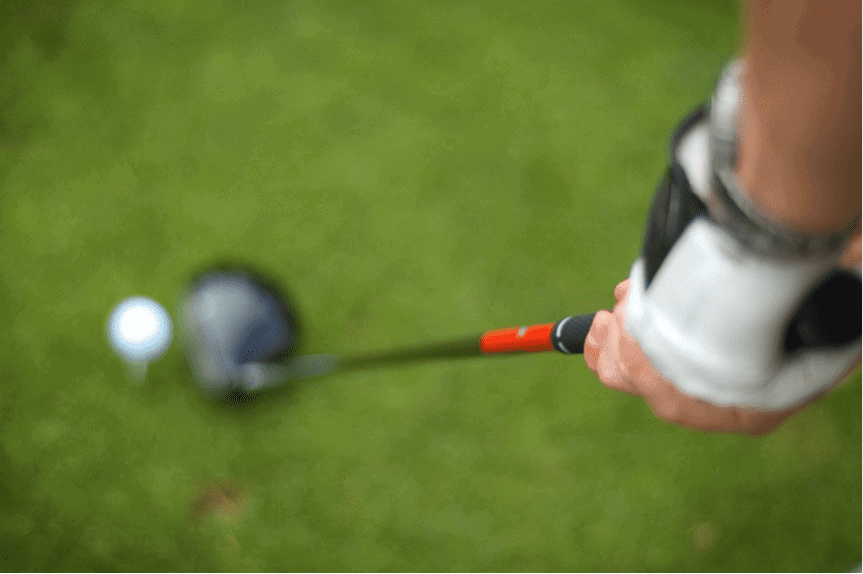 As a coach, this is where you want your athletes to eventually be. You want them to be able to unconsciously perform a task to achieve success. But, it is important that your athletes don’t become too reliant on this skill as the implications of this are complacency or ignorance of new methods. An athlete needs to keep developing and keep learning new skills to continue to grow and succeed in their chosen sport. Learning takes place at Stage 3 of the model. If an athlete jumps ahead to stage 4 too fast or develops poor technical form or habits, they can find them hard to break unless they take a “step back” to stage 3 and re-learn the finer points of their sport.
As a coach, this is where you want your athletes to eventually be. You want them to be able to unconsciously perform a task to achieve success. But, it is important that your athletes don’t become too reliant on this skill as the implications of this are complacency or ignorance of new methods. An athlete needs to keep developing and keep learning new skills to continue to grow and succeed in their chosen sport. Learning takes place at Stage 3 of the model. If an athlete jumps ahead to stage 4 too fast or develops poor technical form or habits, they can find them hard to break unless they take a “step back” to stage 3 and re-learn the finer points of their sport.
This is the reason golfers who are number 1 in the world, undo their swing and re-learn a new swing. Often they take steps back knowing they will take great leaps forward when they again reach stage 4 of their new swing.
The interesting thing about the Conscious Competence Learning Matrix is that progression is always from stage 1 through 2 and 3 to 4. It is not possible to jump stages, even though some may try. This is where an athlete thinks they are a lot better than they actually are or they fail to deliver high performance under competition pressure. For some skills, especially advanced ones, people can also regress to previous stages, particularly from 4 to 3, or from 3 to 2, if they fail to practice and exercise their new skills.
Progression from stage to stage is also often accompanied by a feeling of awakening or a feeling of accomplishment where the athlete knows they have moved into the next learning progression. The same can be said of feelings of “plateaus” where the athlete feels they have not progressed.
A very clear example of this is seen when a person learns to drive a car: the progression from stage 2 (conscious incompetence) to stage 3 (conscious competence) is obvious, as the learner becomes able to control the vehicle and signaling at the same time; and the next progression from 3 to 4 (unconscious competence) is equally clear to learner when he/she is able to hold a conversation while performing a complex maneuver or drive on a LA freeway whilst listening happily to the radio…(maybe this never happens).
Here is where the model is really interesting. Consider this scenario – an athlete you coach who is an elite performer struggles in competition when under pressure. The term commentator’s use for this is choking. This is where an athlete over thinks what they are doing and their usually fluid movement becomes mechanical, just like it was when they were at stage 3 and still “learning”.
What has happened is the athlete has broken a fluid movement into details. They might be thinking about their grip, their feet, posture, shoulder position, breathing and go through every step in detail. The whole point here is stage 3 is not a performance stage. Stage 4 is the high level performance stage. To get back to stage 4, the simplest way is to go back to the big picture and stay away from the step by step process. Think about key words that trigger all the steps at once.
For me, when I was rowing, we would have a single word to co-ordinate the efforts of the whole crew. For example, “Catch” meant seat timing, entry precision, blade depth, grip the water, quiet and accurate entry of the blade. Now in any competition, to think about all those things at once would send you crazy. There is no mental capacity to process like this when your heart rate is 180 and lactate levels are escalating in your body. So we shorten all this to ‘catch’. Then we focus on the next part of the stroke, which for us was legs, then finishes, etc. Four simple words to describe the entire process of rowing, and rowing Coaches are well known for talking about the rowing stroke for hours on end.
Often a coach’s biggest challenge is to help their athletes create their key words and keep them at stage 4 of the Conscious Competence Learning Matrix when performing, then post performance to step back to stage 3 to evaluate what worked well and what needs to improve.
As a coach, we also need to remember that each person possesses natural strengths and preferences, which can be determined through looking at an individual’s AthleteDISC Profile.
These different behaviors, learning styles and strengths and limitations can affect attitudes and commitments towards learning, as well as abilities in developing competence in different disciplines, because ultimately, certain DISC Profiles prefer and possess certain aptitudes and skills. Once you understand this, you can work with your athletes to help them achieve success in a way that is meaningful to them as individuals. It is why, when teaching (coaching) we have to be able to use language that suits our athlete’s preferences. Also certain profiles such as the D and I, are more likely to want to jump through the stages or even the opposite where S or C profiles need to be pushed a little to get to the next stage.
In summary, it is useful to help your athletes understand this Conscious Competence Learning Matrix model so they can be more aware of where they are at with various skills for their sport. It is also important that we as coaches do not assume they are at a higher or lower level than they actually are. Finally, make sure that you as a coach, are able to coach from stage 3. An athlete is not likely to respond well to our coaching if we coach from stage 4. We have to go back to stage 3 where we can clearly explain the steps and processes for skill development.
At Athlete Assessments we’re here to provide you with excellence in service and to help you be your best. If there is anything we can do to be of service, don’t hesitate to contact us.
Recommended Articles
As we all know, our personality impacts our behavior and as such has a direct impact on our coaching style. However, unlike personality, which is relatively stable, a coach’s style is a preferred pattern of behavior and as such it can be changed or adapted depending on the situation. Most of all though, a coach’s style can be changed or adapted if they are aware of their style preference and what style will give them the results they need.
Video Presentation by Bo Hanson, 4x Olympian and Coaching ConsultantIn this video clip, Bo talks about coaching athletes on their sporting behaviors. Behavior is observable and it is what people do. Certain behaviors create certain results. …
Have you ever noticed how some athletes “get” instructions immediately, while for others it takes a while for things to click? If you’re involved in coaching this is something you’ve had to deal with on numerous occasions. Many Coaches develop their own ways of working with their athletes learning styles and having a well-proven framework can be extremely useful. We understand all athletes are unique and cannot be coached in exactly the same way because as athletes (and people in general) everyone has their own unique way of learning.
Which “Four Letter Word” is More Useful in Sport? While there is a little humor in the title of this article, at Athlete Assessments we believe it’s always best to share knowledge. We are regularly asked about the different types of profiling, assessments, and other development tools available in sport (and business) and how they compare to our own use of the DISC Assessment. Most commonly, we are asked to compare MBTI and DISC.
Many of our clients ask us for help on what we prescribe for best practice sport pre-season preparation, focusing on both mental and physical development. This article is written to give you the exact methods we…



